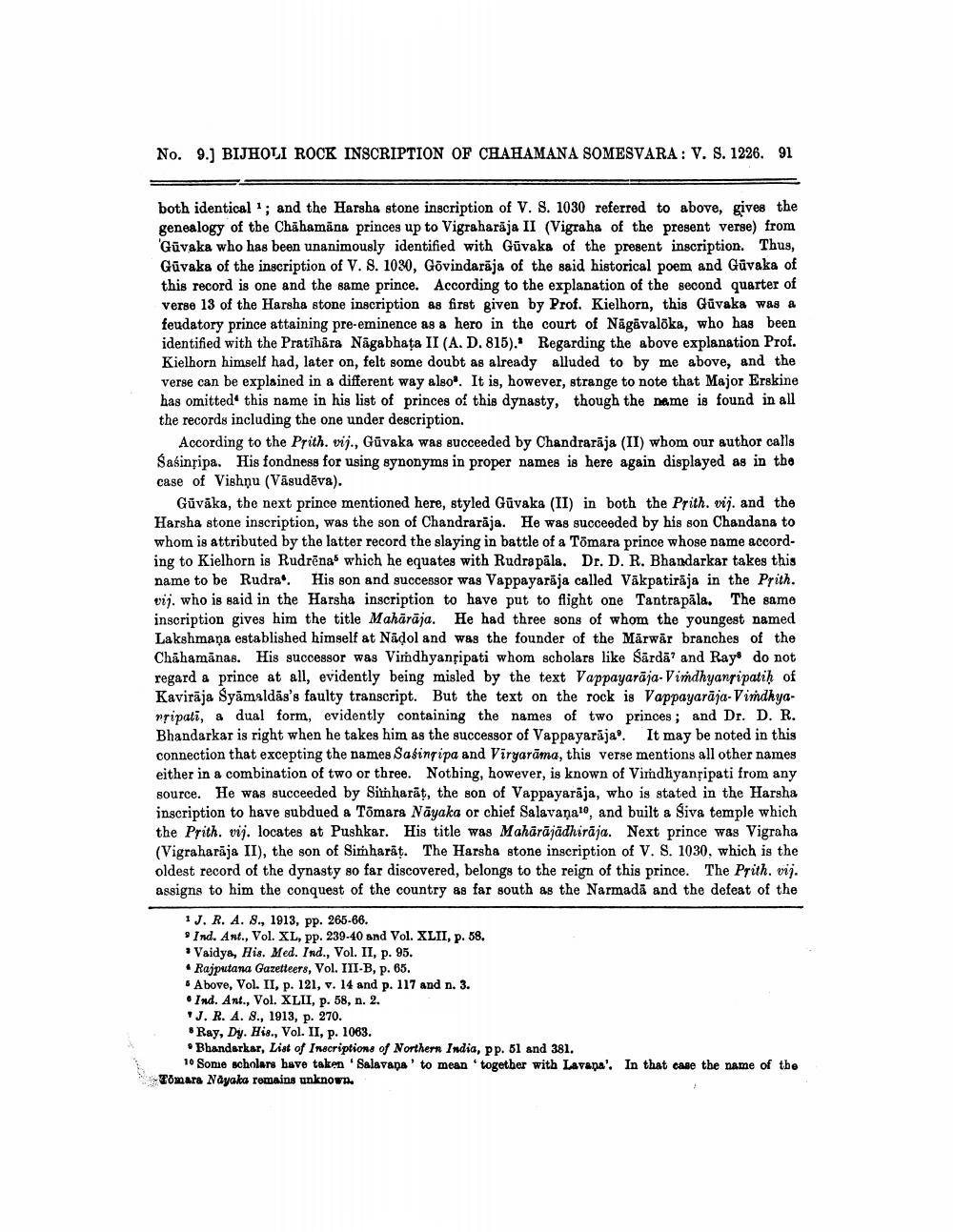________________
No. 9.) BIJHOLI ROCK INSCRIPTION OF CHAHAMANA SOMESVARA: V. S. 1226. 91
both identical ; and the Harsha stone inscription of V. S. 1030 referred to above, gives the genealogy of the Chāhamāna princes up to Vigraharāja II (Vigraha of the present verse) from Gūvaka who has been unanimously identified with Gūvaka of the present inscription. Thus, Gūvaka of the inscription of V. S. 1030, Govindarāja of the said historical poem and Gūvaka of this record is one and the same prince. According to the explanation of the second quarter of verse 13 of the Harsha stone inscription as first given by Prof. Kielhorn, this Güvaka was a feudatory prince attaining pre-eminence as a hero in the court of Nägivalóka, who has been identified with the Pratihara Nagabhata II (A. D. 815). Regarding the above explanation Prof. Kielhorn himself had, later on, felt some doubt as already alluded to by me above, and the verse can be explained in a different way also. It is, however, strange to note that Major Erskine has omitted this name in his list of princes of this dynasty, though the name is found in all the records including the one under description.
According to the Prith. vij., Güvaka was succeeded by Chandrarāja (II) whom our author calls Sasinpipa. His fondness for using synonyms in proper names is here again displayed as in the case of Vishnu (Vāsudēva).
Güvāka, the next prince mentioned here, styled Güvaka (II) in both the Prith. vij. and the Harsha stone inscription, was the son of Chandrarāja. He was succeeded by his son Chandana to whom is attributed by the latter record the slaying in battle of a Tõmara prince whose name according to Kielhorn is Rudrēnas which he equates with Rudra päla. Dr. D. R. Bhandarkar takes this name to be Rudra His son and successor was Vappayarāja called Väkpatirāja in the Prith. vij. who is said in the Harsha inscription to have put to flight one Tantrapāla. The samo inscription gives him the title Mahārāja. He had three song of whom the youngest named Lakshmana established himself at Nādol and was the founder of the Mārwär branches of the Chāhamānas. His successor was Vimdhyansipati whom scholars like Sardar and Ray8 do not regard a prince at all, evidently being misled by the text Vappayarāja-Vindhyansipatiḥ of Kavirāja Syāmaldās's faulty transcript. But the text on the rock is Vappayarāja Vindkyanripati, & dual form, evidently containing the names of two princes; and Dr. D. R. Bhandarkar is right when he takes him as the successor of Vappayarāja. It may be noted in this connection that excepting the names Sasinpipa and Viryarāma, this verse mentions all other names either in a combination of two or three. Nothing, however, is known of Vimdhyansipati from any source. He was succeeded by Simharāt, the son of Vappayarāja, who is stated in the Harsha inscription to have subdued a Tomara Nayaka or chief Salavana', and built a Siva temple which the Prith. vij. locates at Pushkar. His title was Mahārājādhiraja. Next prince was Vigraha (Vigraharāja II), the son of Simharät. The Harsha stone inscription of V. S. 1030, which is the oldest record of the dynasty so far discovered, belongs to the reign of this prince. The Prith. vij. assigns to him the conquest of the country as far south as the Narmadā and the defeat of the
HJ. R. A. 8., 1913, pp. 265-66. . Ind. Ant., Vol. XL, Pp. 239-40 and Vol. XLII, p. 58. * Vaidya, His. Med. Ind., Vol. II, p. 95. • Rajputana Gazetteers, Vol. III-B, p. 65. 5 Above, Vol. II, p. 121, v. 14 and p. 117 and n. 3. . Ind. Ant., Vol. XLII, p. 58, n. 2. "J. R. A. 8., 1913, p. 270.
Ray, Dy. His., Vol. II, p. 1063. • Bhandarkar, List of Inecriptions of Northern India, PP. 51 and 381.
10 Sone scholars have taken 'Salavana' to mean together with Lavapa'. In that case the name of the Tomara Nayaka remains unknown.




